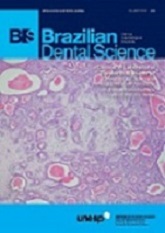Influence of cleansing agents on enamel and dentin bond strength to a one-step adhesive system
DOI:
https://doi.org/10.14295/bds.2014.v17i1.948Resumen
Objective: The aim of this study was to detect the influence of application mode of cleansing agents, on enamel and dentin during the adhesion process of a one-step adhesive system.
Materials and Methods: 24 human molars were sectioned into halves along the long axis for enamel and dentin tests. The cleansing agents used were hydrogen peroxide, anionic detergent, and antiseptic solution. In the experiment, these agents were applied with and without friction on enamel and dentin surfaces. A one-step adhesive system (Clearfil S3 Bond) was applied on dental surface and composite resin cylinders were built using Tygon tubing molds. After 24 h, ?SBS test (1 mm/ min) and fracture analysis were performed. Results: There was no statistically significant difference in bond strength values regarding the application mode of cleansing agents for enamel and dentin (p?0,05).
Conclusions: Regarding bond strength, application mode of the cleansing agents used in this study presented the same behavior.
Descargas
Descargas
Publicado
Cómo citar
Número
Sección
Licencia
Brazilian Dental Science uses the Creative Commons (CC-BY 4.0) license, thus preserving the integrity of articles in an open access environment. The journal allows the author to retain publishing rights without restrictions.
=================
COPYRIGHT TRANSFER AND RESPONSIBILITY STATEMENT
(PDF)
For all articles published in the BDS journal, copyright is retained by the authors. Articles are licensed under an open-access Creative Commons CC BY 4.0 license, meaning that anyone may download and read the paper for free. In addition, the article may be reused and quoted, provided that the original published version is cited. These conditions allow for maximum use and exposure of the work while ensuring that the authors receive proper credit. All metadata associated with published articles is released under the Creative Commons CC0 Universal Public Domain Dedication.
Before the submission, authors must obtain permission to reproduce any published material (figures, schemes, tables, or any extract of a text) that does not fall into the public domain or for which they do not hold the copyright. Permission should be requested by the authors from the copyright holder (usually the Publisher, please refer to the imprint of the individual publications to identify the copyright holder).
The authors hereby attest that the study is original and does not present manipulated data, fraud, or plagiarism. All names listed made a significant scientific contribution to the study, are aware of the presented data, and agree with the final version of the manuscript. They assume complete responsibility for the ethical aspects of the study.
This text must be printed and signed by all authors. The scanned version should be submitted as supplemental file during the submission process.




























